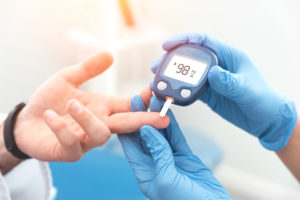- Trey Boyd, DMSc, PA-C
The Patient’s Perspective
Have you recently been diagnosed with diabetes? Is there a history of diabetes in your family? Are you experiencing symptoms?
With a diagnosis like diabetes, there can be many things to think about at one time, and it is easy to get confused or overwhelmed. The purpose of this post is to help you better understand the basics of diabetes and what can be done to help manage it.
What is Diabetes?
Diabetes is a chronic disease in which your body cannot properly react to the sugar in your blood. Each time you drink and eat food, your body will digest parts of what you consume into a type of sugar the body can use, called “glucose.” Glucose travels around your body to provide energy to your cells, like your muscles. The body uses a special hormone called insulin to move the glucose from your bloodstream into your cells. With diabetes, your body’s insulin either isn’t working as it should or is not able to be made. When you don’t have enough insulin, the glucose stays in your blood and gets too high (“high blood sugar”). When you have high blood sugar for a long period of time, this can lead to other health problems, like damage to your eyes, heart, kidneys, blood vessels and nerves.1
There are four major types of diabetes: Pre-Diabetes, Diabetes Type 1, Diabetes Type 2, and Gestational Diabetes. For this post, I will focus on Pre-Diabetes (a condition in which your blood sugar is above normal limits, but not enough to be considered diabetic) and Type 2 Diabetes (a condition in which your body cannot use your insulin hormone properly), which is the most common type of diabetes.1
What are the Risk Factors for Pre-Diabetes and Diabetes Type 2?
Some of the risk factors for Type 2 Diabetes, many of which are preventable, include:
- Being overweight
- Not exercising or being physically active
- Eating nutrient-poor foods
- Being over 45 years of age
- Having a family history of Type 2 Diabetes
- Having Pre-Diabetes
Some ethnic groups are also at higher risk for developing Type 2 Diabetes, such as African-Americans, Latino Americans and American Indians.2
Your health care provider will take your medical history, including a social and family history, perform a physical examination, and discuss these risk factors with you during your health visit.
What are the Symptoms of Diabetes?
Symptoms can develop over a long period of time. Some of the most common symptoms of Type 2 Diabetes include:
- Extreme thirst
- Urinating a lot throughout the day or night
- Feeling tired
- Having tingling feelings in your feet or hands
- Blurry vision
- Slow-healing sores on your skin
- A high number of infections (like bladder infections)
How Do I Know if I Have Diabetes?
If you think you might have diabetes, make an appointment with your Certified PA or other health care provider. They may recommend tests for diabetes if you have risk factors or symptoms and can check for diabetes with a blood test. Most of the tests you will experience when looking for diabetes include a fasting blood sugar test (before you’ve eaten your first food for the day), an A1c test, a random blood glucose test, or a glucose tolerance test.
How is Diabetes Treated?
There is no cure for diabetes, but diabetes can be managed effectively using a combination of medications and lifestyle changes.3 Your health care provider will discuss these options with you during regular, frequent office visits. Medications used to treat diabetes can include pills you take by mouth, non-insulin medication that you inject, and different types of insulin that you inject.
Pre-Diabetes and Type 2 Diabetes can be delayed or prevented. Eating healthy foods at the right time, getting routine exercise, and having regular follow up visits with your health care provider are excellent ways to prevent the onset of diabetes. If you have a blood test that confirms you have diabetes (or Pre-Diabetes), starting a healthy lifestyle is a great way to control it to help prevent complications in the future.
What Kinds of Foods are Considered Healthy?
There are many healthy food options that can help to prevent or manage diabetes. I oftentimes recommend my patients follow the “Plate Method.” Visualize a regular dinner plate as a circle. For each meal, try to fill half of the plate with non-starchy vegetables (green beans, carrots, broccoli), a quarter of the plate with lean protein (chicken, turkey, eggs, beans, lentils), and a quarter of the plate with grains and carbs (fruit, yogurt, whole grain bread). Water and low-calorie drinks are preferred over juices or high-calorie sodas. Combining a healthy diet with regular, moderate exercise can help manage diabetes. 4
There are many resources available to patients to help with meal planning, grocery shopping, and food preparation to help ensure that a healthy diet is attainable. The American Diabetes Association (ADA), the Centers for Disease Control and Prevention (CDC), and the International Diabetes Federation (IDF) have a lot of free resources for patients, families and caregivers to help better understand and manage diabetes.
References
- Diabetes Symptoms, Causes, & Treatment | ADA. Accessed September 22, 2021. https://www.diabetes.org/diabetes
- CDC. Diabetes Risk Factors. Centers for Disease Control and Prevention. Published April 23, 2021. Accessed September 22, 2021. https://www.cdc.gov/diabetes/basics/risk-factors.html
- IDF Diabetes Atlas, ninth edition. Accessed September 22, 2021. https://diabetesatlas.org/upload/resources/material/20200302_133351_IDFATLAS9e-final-web.pdf
- Uusitupa M, Khan TA, Viguiliouk E, et al. Prevention of Type 2 Diabetes by Lifestyle Changes: A Systematic Review and Meta-Analysis. Nutrients. 2019;11(11):2611. doi:10.3390/nu11112611


